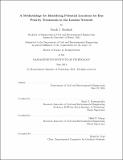A methodology for identifying potential locations for bus priority treatments in the London Network
Author(s)
Machlab, Farah J. (Farah Jacinthe)
DownloadFull printable version (19.80Mb)
Other Contributors
Massachusetts Institute of Technology. Department of Civil and Environmental Engineering.
Advisor
Haris N. Koutsopoulos and Mikel E. Murga.
Terms of use
Metadata
Show full item recordAbstract
Bus priority strategies provide preferential treatment to buses operating in mixed traffic. This thesis aims at developing a methodology for identifying locations for potential bus priority implementation, referred to as hot spots. While hot spots can occur at various spatial levels, the research focuses on identifying hot spots at the intersection level. Several measures are developed that describe the performance of bus routes through an intersection. This research focused on measuring the running time variability, speed, and delay of routes through an intersection. Using these route performance measures, two intersection-level measures are defined. The first is an aggregate measure which weighs individual route performance by the number of trips made through the intersection, and the second is a normalized range measure that characterizes the amount of variation among routes. A methodology for identifying hot spot intersections using a ranking approach is proposed. Intersections that are ranked at the top in all aggregate measures are identified as hot spots, as well as those that are top ranking in all normalized range measures. The final list of hot spots also includes intersections that are top ranking in individual measures but were not selected by the combined ranking. The methodology was applied to the London network and the resulting list of intersection hot spots was compared with a list of hot spots determined by Transport for London, London's public transit agency. This research also aimed at understanding the causes that influence overall route performance. A number of models were estimated using traffic and operating characteristics, in addition to route and ridership attributes of a sample of routes in London. The results suggested that traffic and intersection delay are significant contributors to decreased speeds, and bus lanes with lower bus occupancy are effective in increasing speeds.
Description
Thesis: S.M. in Transportation, Massachusetts Institute of Technology, Department of Civil and Environmental Engineering, 2014. Cataloged from PDF version of thesis. Includes bibliographical references (pages 142-144).
Date issued
2014Department
Massachusetts Institute of Technology. Department of Civil and Environmental EngineeringPublisher
Massachusetts Institute of Technology
Keywords
Civil and Environmental Engineering.